Tag: Capacitive touch screen Resistive touch screen
This article refers to the address: http://
There are currently several types of touch screens: resistive (double layer), surface capacitive and inductive capacitive, surface acoustic wave, infrared, and curved wave, active digitizer and optical imaging. . They can be divided into two categories, one requires ITO, such as the first three touch screens, and the other type does not require ITO, such as the latter screens.
Touch screens are everywhere around us. In the field of personal portable devices such as PDAs, touch screens save space and are easy to carry, as well as better human-computer interaction.
There are currently several types of touch screens: resistive (double layer), surface capacitive and inductive capacitive, surface acoustic wave, infrared, and curved wave, active digitizer and optical imaging. . They can be divided into two categories, one requires ITO, such as the first three touch screens, and the other type does not require ITO, such as the latter screens. Currently, resistive touch screens and capacitive touch screens using ITO materials are the most widely used on the market.
Resistive touch screen
ITO is the abbreviation of indium tin oxide, which is a transparent conductor. The properties of this material can be adjusted by adjusting the ratio of indium to tin, the deposition method, the degree of oxidation, and the size of the grains. Thin ITO materials have good transparency but high impedance; thick ITO materials have low impedance, but transparency is poor. When depositing on PET polyester film, the reaction temperature should be lowered to below 150 degrees, which will lead to incomplete oxidation of ITO. In the subsequent application, ITO will be exposed to air or air barrier, and its resistance per unit area will be affected by auto-oxidation. Change of time. This makes the resistive touch screen require frequent correction.
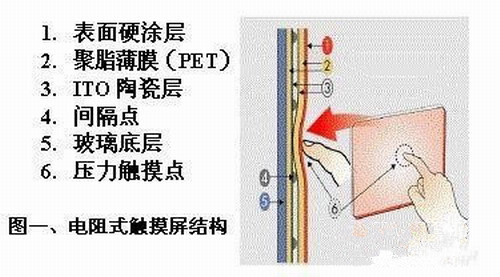
Figure 1 is a side cross-sectional view of a resistive touch screen. The surface touched by the finger is a hard coat to protect the underlying PET layer. The PET layer is a very thin, flexible PET film that bends downward when the surface is touched and allows the underlying two layers of ITO coating to contact each other and connect the circuit at that point. Between the two ITO layers is an isolation spacer that is about one thousandth of an inch thick to separate the two layers. At the bottom is a transparent hard underlayer used to support the structure above, usually glass or plastic.
The multilayer structure of the resistive touch screen causes a large loss of light. For handheld devices, it is often necessary to increase the backlight to compensate for the problem of poor light transmission, but this also increases battery consumption. The advantage of the resistive touch screen is that its screen and control system are relatively cheap and the response sensitivity is also very good.
Capacitive touch screen
Capacitive touch screens also require the use of ITO materials, and their low power consumption and long life, but the higher cost makes it less of a concern before. Apple's iPhone provides a friendly human-machine interface, and the smooth operation performance makes the capacitive touch screen popular in the market. Various capacitive touch screen products are available. And as the process progresses and batches, its cost continues to decline, and it is beginning to show a trend of gradually replacing resistive touch screens.
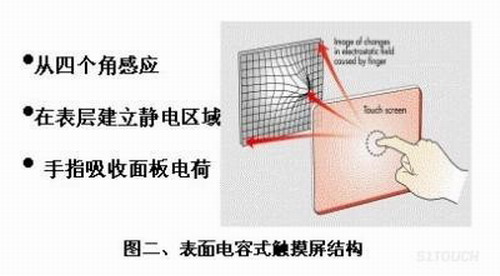
The surface capacitive touch screen uses only a single layer of ITO. When a finger touches the surface of the screen, a certain amount of charge is transferred to the human body. In order to restore these charge losses, the charge is replenished from the four corners of the screen, and the amount of charge replenished in each direction is proportional to the distance of the touch point, from which we can derive the position of the touch point.
Surface Capacitive ITO coatings typically require linearized metal electrodes on the perimeter of the screen to reduce the effect of corner/edge effects on the electric field. Sometimes there is an ITO shield under the ITO coating to block noise. The surface capacitive touch screen needs to be calibrated at least once to be used.
Compared to surface capacitive touch screens, inductive capacitive touch screens can penetrate thicker overlays without the need for correction. Inductive Capacitance etches different ITO modules on two ITO coatings, taking into account the total impedance of the module, the impedance of the connection between the modules, and the parasitic capacitance generated at the intersection of the two ITO modules. Moreover, in order to detect finger touch, the area of ​​the ITO module should be smaller than the finger area, and when a diamond pattern is used, the diagonal length is usually controlled to 4 to 6 mm.
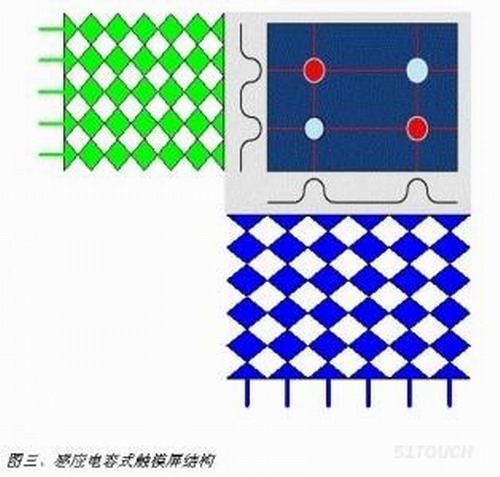
In Figure 3, the green and blue ITO modules are placed on two ITO coatings, which can be viewed as a continuously changing slider in the X and Y directions. The ITO modules in the X and Y directions need to be scanned separately. Get the position of the touch point and the track of the touch. Between the two layers of ITO coating is a PET or glass barrier, which has better light transmission, can withstand greater pressure, and has a higher yield. It can be directly coated on the LCD surface by a special process, but it is also heavier. The thinner the spacer layer, the better the light transmittance, but the larger the parasitic capacitance between the two layers of ITO.
The touch position detected by the inductive capacitive touch screen corresponds to the intersection point at which the maximum capacitance change value is sensed. For the X axis or the Y axis, the signal amount of different ITO modules is weighted and averaged to obtain the position amount, and the system is then under the touch screen. Touch points or tracks are displayed on the LCD.
When there are two finger touches (two points in red), there will be two maximum values ​​on each axis. There are two possible combinations, and the system cannot accurately determine the judgment. This is what we usually call the mirror. Point (two points in blue).
In addition, the underside of the touch screen is the LCD display, the surface of which is also conductive, which will produce parasitic capacitance with the ITO-coated ITO module. We usually need to keep a certain air layer between the two layers. Reduce the effects of parasitic capacitance.
Capacitive touch screen solution
In today's capacitive touchscreen solutions, CypressPSoC products are leading the way in programmable, flexible design, consistent, and efficient PSoCExpress/PSoCdesigner development environments.
PSoCCapSense technology is implemented using CSA or CSD modules based on the principle of capacitive sensing. There is parasitic capacitance between adjacent sensing modules or wires on the PCB or touch screen (see Cp in Figure 4). When a finger approaches or touches two adjacent sensing modules, it is equivalent to adding two capacitors. It is equivalent to the capacitor Cf connected in parallel on Cp. This change in capacitance can be detected using PSoC's CSA and CSD techniques to determine if there is a finger touch.
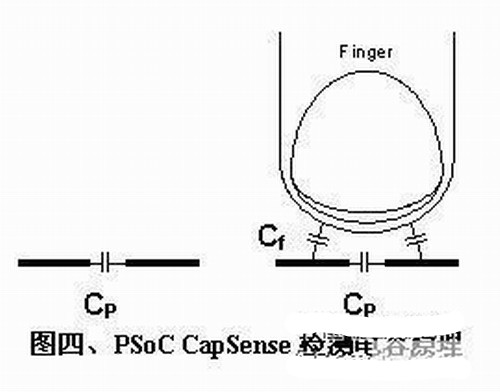
The advantages of the PSoC touchscreen solution are also reflected in:
1. It is a single-chip solution that reduces external components and reduces overall system BOM cost compared to traditional solutions.
2. By using I2C-USBBridge and other related tools, combined with the PSoCExpress/PSoCdesigner development environment, you can greatly save development time and cost.
3. PSoC's internal IO and various analog/digital modules enable dynamic reconfiguration, which can be updated to accommodate new requirements without modifying the schematic and PCB. It also supports a variety of communication interfaces I2C / UART / SPI / USB, etc., can be easily connected to the host of various interfaces, which will reduce the cost of system updates.
4. PSoC can be flexibly set for external environment changes - RF interference / temperature change / power fluctuations, and has been widely used in touch control of LCD displays, mobile phones, digital cameras and white goods.
5. In addition to controlling touch, PSoC can also realize value-added functions such as LED backlight control, motor control, power management, and I/O expansion.
PSoC has been applied to a variety of touch screens. If you want to control the surface capacitive touch screen, you can use the CSD module by the CY8C21x34 or CY8C24x94 series, as shown in Figure 5. The control of the sensing capacitive touch screen can be realized by the CY8C20x34 series through the CSA module, or by the CY8C21x34 or CY8C24x94 series through the CSD module, as shown in Figure 6.
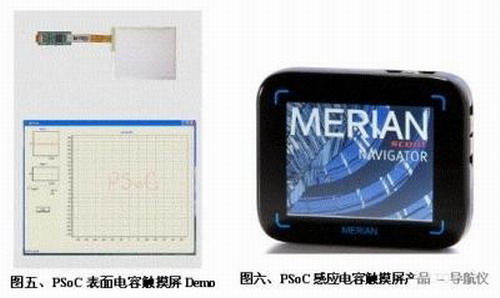
In the design of touch screen products, there is a trade-off between performance and cost. Resistive touch screens are less expensive, competitive, and have limitations in performance and application.
1. Capacitive touch screens only need to be touched, without the need for pressure to generate a signal.
2. The capacitive touch screen requires only one or no correction after production, and the resistance technology requires regular correction.
3. The life of the capacitor solution will be longer because the components in the capacitive touch screen do not need any movement. In the resistive touch screen, the upper ITO film needs to be thin enough to be elastic so as to be bent downward to contact the underlying ITO film.
4. Capacitor technology is superior to resistor technology in terms of optical loss and system power consumption.
5. The choice of capacitor technology or resistance technology depends mainly on the object touching the screen. If it is a finger touch, a capacitive touch screen is a good choice. If you need a stylus, whether it's plastic or metal, a resistive touch screen can do the job. A capacitive touch screen can also use a stylus, but a special stylus is required to match.
6. Surface capacitive type can be used for large-size touch screen, and the phase cost is also low, but currently can not support gesture recognition; inductive capacitive type is mainly used for small and medium size touch screen, and can support gesture recognition.
7. Capacitive technology is wear-resistant and has a long service life. The maintenance cost is low when the user uses it, so the overall operating cost of the manufacturer can be further reduced.
The development trend of capacitive touch screen
Capacitive touch screens have been applied to iPhones and other handheld devices. Positioning single-point tracks/simulating mouse double-clicks is its basic function, and the identification and application of multi-finger gesture operations has become a hot spot in the current market. In a portable application, the user can only use the other hand to hold the device, so it is particularly important to recognize multi-finger grab/panning, stretching/compression, rotation, and page turning operations. The PSoC inductive capacitive touch screen enables multi-point detection to support two-finger gesture recognition. It is foreseeable that capacitive touch screens that support gesture recognition will shine in the market.
Aluminum Electrolytic Capacitors
Aluminum Electrolytic Capacitor,1Uf Capacitor,2.2Uf Capacitors,4.7Uf Capacitors
JINGGANGSHAN MEICHENG ELECTRONIC TRADING CO.,LTD , https://www.meicheng-tra.com